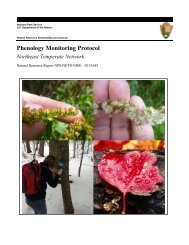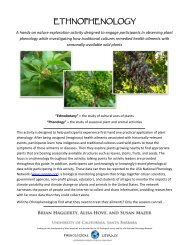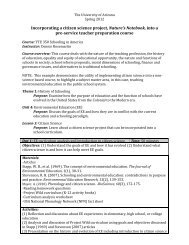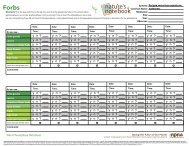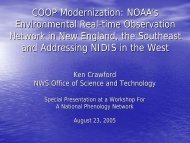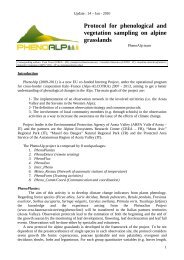The Phenology Handbook - USA National Phenology Network
The Phenology Handbook - USA National Phenology Network
The Phenology Handbook - USA National Phenology Network
Create successful ePaper yourself
Turn your PDF publications into a flip-book with our unique Google optimized e-Paper software.
Scorpioid cyme<br />
Essentially a raceme inflorescence that is coiled. Flowering begins with the lowest<br />
flowers on the stem and progresses upward as the inflorescence uncoils to an erect<br />
spike-like structure. <strong>The</strong> open flowers are typically found at the apex of the coil.<br />
Catkin<br />
Catkins are hanging spikes, typically found on trees.<br />
HABIT<br />
<strong>The</strong> habit of a plant is its characteristic appearance and growth form. Plant habits that are common to the<br />
temperate zone include:<br />
• Herbaceous – A non-woody flowering plant that can be annual, biennial, or perennial; the stems<br />
remain flexible and relatively soft. Examples in the Santa Barbara region include wildflowers such<br />
as Lupine and California Poppy, grasses, and many culinary herbs such as cilantro, parsley, and<br />
basil.<br />
• Forb – herbaceous flowering plants, excluding grasses. Typically used when referring to wildflowers.<br />
We use this term in the Phenophase Quick-Guide.<br />
• Shrub – A woody perennial plant, typically with multiple main stems. Shrubs can be evergreen or<br />
deciduous, and height is commonly 3m. Common<br />
examples in the Santa Barbara area include Eucalyptus, oaks, Sycamore, California Bay, and<br />
pines.<br />
<strong>The</strong> habit of your targeted plant will have a strong effect on how you record its leafing and flowering<br />
phenophases. In forbs, the very first appearance of the phenophase (e.g., first flower or leaf) marks the<br />
onset of a given phenophase, just as you’d expect. In shrubs and trees, however, we must accomodate<br />
their vastly larger size and number of branches. Consequently, the onset of a given phenophase in shrubs<br />
and trees is marked by the appearance of the phenophase in three different locations (branches for leafing<br />
phases, inflorescences for flowering phases) before we record it. Once you identify the habit of your<br />
targeted species, simply find the appropriate cell in the Quick-Guide to find the quick definition of each<br />
leafing or flowering phenophase.<br />
36



